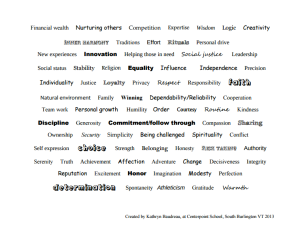Identify the Essential in Classroom Management

When making classroom policies, rules, or guidelines, it’s essential to be able to answer the question: what’s the bottom line? When we go beyond our content, curriculum, or instructional methods: what is truly important about this space and this community as a place of learning?
The bottom line can be framed in a few different ways:
Classroom mission statement. With your students, examine the mission statements of popular companies, nonprofits, and even your school. Invite small groups to propose a mission statement and then combine or take a vote.
Shared values. In my classroom, we used a values cloud worksheet (PDF) to consider which qualities we each valued in school and then shared with one another so we could find some common ground. Some examples: cooperation, trust, honesty, leadership. We took a “fist of five” tally to see how strongly each person felt about each value (holding up one finger meant not very strongly, all five meant “this is so important!”).

The values cloud worksheet can be used in other ways: students can circle the characteristics they value, cross out the ones they don't, and highlight/star/underline for varying degrees of importance. The worksheet can also help with conflict resolution. Two students independently mark up what they value and then a facilitator helps them to trade sheets and recognize the places where they actually agree on the "big stuff," which helps guide resolution about the small things.
Just the essentials. In the absence of a more collaborative process, you can identify for yourself as the teacher/facilitator what the true essentials of your classroom are for you. For me, my two essentials are safety and respect. We can always add to these or elaborate upon them, but I know at the end of the day I will feel good if I’ve fostered those two things.
Once you’ve identified your bottom line, now it’s time to communicate it. Invite students to craft signage or art for your classroom that proclaim these values visibly in your space.
Classroom management is complicated when you reactively create rules and consequences based on particular behavior that comes up. Which consequence did I set for which behavior, and why, and what happens if a behavior falls outside my specific rule? When, instead, we take the time to identify the bottom line, our decision-making streamlines. Instead of blanket “no cell phones,” “no gum,” or “no side conversations” rules, I create a “yes respect” and “yes safety” environment. When students clearly know and agree that safety and respect are the bottom line, any behavior can be contextualized against what’s important, rather than a seemingly arbitrary set of rules.
For example, if a student is on her cell phone playing a game while another student is giving a presentation, we can decide as a class that this doesn’t constitute respect and develop a plan for what we think would better show our respect to the presenter. However, another student might let the class know at the beginning of the period that she will be texting her mom about halfway through class to check on how her dog’s vet procedure went, and we might all agree that this type of cell phone use, paired with the student’s proactivity, does indeed constitute respect to our class.
When we involve students in identifying what’s important, communicate these values clearly, and invite students into the process of upholding these values, we democratize what can otherwise turn into a power struggle. We make students carriers of a positive culture. We teach them how to be in community.